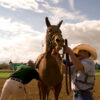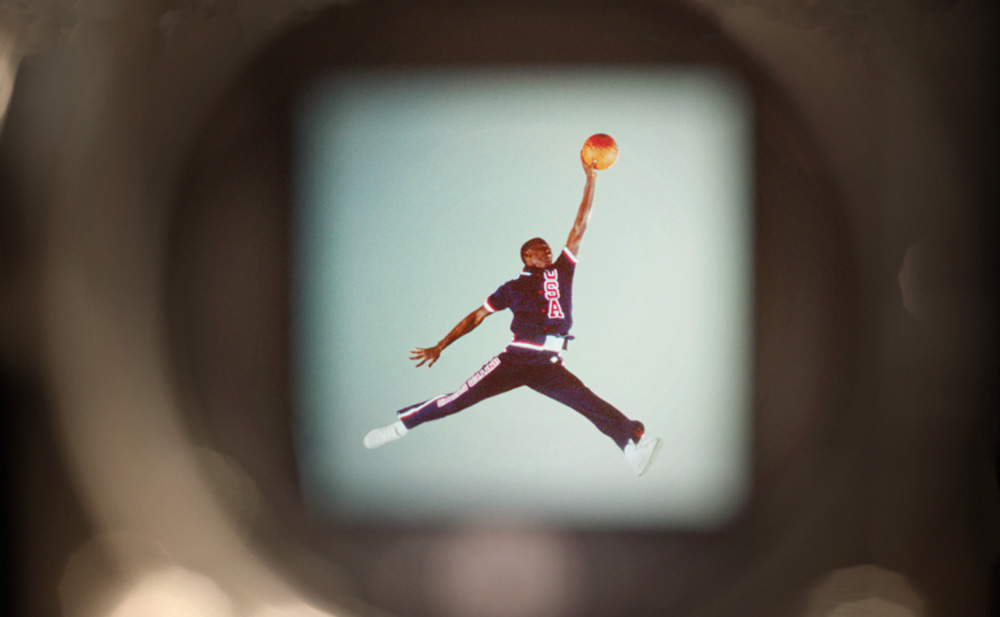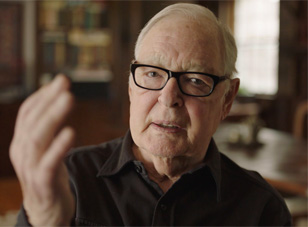Co Rentmeester was cursed with a gift. After his mother gave his father a Rolleiflex when he was growing up in Amsterdam, the camera would be used most by the nine-year-old, taking pictures as early as the 1940s when planes engaged in World War II would fly overhead and he would return to it after college, covering major world events from the Watts Riots to the war in Vietnam, which led to a spot at the 1972 Olympics when editors at Time Magazine knew in addition to being one of their best photographers, he was once a competitive rower.
One thing clearly leads to another in “Jumpman,” a new documentary short which revolves around Renmeester’s most famous photograph of a young Michael Jordan with his outstretched arm that would become the logo for his Nike brand, with the photographer hired by Life to shoot the Chicago Bulls’ #3 pick in the 1984 draft in advance of that year’s Olympics, having established himself as one of the best observers of the sports over a decade earlier. While director Tom Dey meticulously illustrates how Rentmeester put himself in position to take the iconic image within the context of his career, more crucially it depicts how he picked all the right spots on the day – from the round knoll in Chapel Hill, North Carolina where it looked like the greatest basketball player of all time could defy the earth’s gravity to preparing to capture the exact moment in which he would freeze in the air and one could admire the elegance of his physique — to capture the aura around this once-in-a-generation athlete.
Hearing a master like Rentmeester describe his process in such thorough detail would be captivating enough, but “Jumpman” shows how difficult it is for him to bring these memories back when after Nike adopted the image as their own, replicating the shot that they’d eventually use for the silhouette that now adorns all Jordan brand products and claiming that it was an original design separate from the photo it was clearly taken from. Rentmeester never saw any financial benefit from the picture, other than the general fee he earned from taking it, and it became a source of pain rather than pride as Jordan’s superstardom made the label ubiquitous and unavoidable. Dey, who is primarily known for making such comedies as “Shanghai Noon” and “Failure to Launch,” is able to show another side in telling the story of his father-in-law who endured the punishing experience of an unsuccessful civil suit, leaving a bitter taste in his mouth about the profession that he invested so much in to be one of the best, while it’s clear neither the skill nor the passion that accumulated over the years could entirely go away.
As the film makes its premiere at Tribeca this week, the director graciously took the time to talk about why he was compelled to tell this story now, all the work involved on his end to make this particular image come alive again and getting some measure of justice for its subject.
A couple of things put it into motion. Obviously, I’m married to one of [Co]’s daughters, who’s a photographer as well, so I have been living with this story at arm’s length for the last couple of decades and I witnessed the weight that he carried over decades. I had seen what I consider to be justifiable anger [over the rights to the image] was exhausting, and being his son-in-law, I wanted to see if there was any way that I could provide some relief to him and perhaps even find some peace on the other side of the verdict that was handed against him.
I also was working on this documentary with my dad and unfortunately, he passed away before I could finish it, so as I was putting together videos for his memorial, I was thinking, “God, I have to do this with Co,” my wife’s father, as well, so it started as a [conversation over] Zoom about it, just getting it down for the archives of our family. Then almost immediately, I realized I had to make a documentary about this. I discovered that there were a lot of themes that I’m passionate about as well — [the idea that] photography is an art that needs better protection and a photograph is more than the sum of its parts — and I wanted to explore what happens when you have an artist who’s willing to literally die for his work and that work is stolen from him. How do you bounce back from that? So those were some of the things that were interesting to me and ignited the fuse to get this thing done. From that point, it was about trying to figure out the best way to tell his story.
Was he immediately onboard when it clearly was a painful experience?
He was on board with it, partly because he had seen a rough cut of the documentary I was doing with my dad, so he knew that I was going to be respectful. But what he was not comfortable with, as I don’t think anyone would be, was when I wanted him to be really open about how much this hurt. That’s what we put at the beginning of the movie, because I was trying to explain to him if if the audience doesn’t see how much this means to you, then it’s not going to mean that much to them. And this is like an Olympic athlete who was very much like Jordan in that he was very demanding on his crews and the people around him in his pursuit of excellence in his field and [part of] a generation where the men were not supposed to show their feelings. So that was uncomfortable for him.
But he was on board because he failed in the courts and and realized that this might be his last chance to share his story with the world and as soon as I found out that he wasn’t he was never allowed to to speak to a jury, I realized, “Hey, there’s an opportunity here for him to address the court of public opinion and I just wanted to capture him telling his story as honestly, and as straightforward as possible. In a really nice reversal, he in turn has given me a voice as well as a filmmaker. I’m just very appreciative that he allowed me to tell this story in a way that I felt would be most compelling and that’s hard to do. That takes courage to put yourself out there like that.
This is your first documentary. Was it much of an adjustment?
Being a narrative feature filmmaker, I had to learn the ropes a bit in in terms of doing it in a documentary style. The main challenge for me on my movies is is generally, “How do I make this feel real, like it’s happening for the first time? How do I make each moment feel honest and truthful?” And with Co’s story, the real was a given, so the challenge then became more about how do I make this story come alive and how can I place the audience inside this experience that happened 40 years ago?
Did having his life in pictures help?
I was familiar with his work, but I had never gone through his archives and that was a very cool thing to suddenly be able to pour over contact sheets of Muhammad Ali and from Vietnam. That expanded my knowledge and appreciation for the breadth of his work, but really, the way that the photographs came into play more had more to do with the idea that I wanted to trace Co’s creative trajectory. As a kid during Armistice of these planes taking off in Amsterdam to then 40 years later, making pictures of Jordan taking off into the sky — and then 40 years later, he’s making pictures with that swan, I wanted to show how Co is the only person who could have taken these photos, [and by extension] who could have made this portrait of Jordan.
I also struggled with, what is the ending of this movie? Because I read recently that we’re living in an age of grievance and I didn’t want to just end with sour grapes, yet I needed to be honest with the fact that it still hurts [that the ruling went against him]. And one day he showed me a print of those clouds without Jordan in it. And he said to me, “In a lot of ways, this is a better photograph without Jordan in it,” and I was dumbfounded. I couldn’t believe he said that. And I said, “What do you mean by that? And he started to explain it and I said, “Hang on a second. I have to get this on camera.” So I went back and did a second shorter interview in the same place just to ask him about that and to get some more clarification around the lawsuit and whether he knew it or not, in that second interview, provided a kind of a key to the movie, which was that gratitude can be an antidote to grievance and an appreciation of the breadth of a photographer’s work is worth much more than any single image. That’s what the photographs provided us — a visual montage of the breadth of his work and of his life.
It’s very cool how you recreate the conditions of how that photograph of Michael Jordan was taken. What was it like figuring that out?
That goes back to trying to figure out how to make the story come alive and I said at one point to my wife, who is a producer on the movie, “I think I have to recreate the the shoot with a Jordan stand in. How do you feel about that?” And being one of my biggest supporters, she said, “I think that’s a terrible idea.” [laughs] But in the end, she came around and when she saw it, she understood that what I was going for was more about sense memory than a reenactment. I just really wanted to feel that moment because it’s a historic moment, but I wanted to do it in a way felt evocative. That was the one day shoot out at Pepperdine and we just we had a lot of fun with that. I think it adds a lot of interesting texture to the film.
From the credits, this looked like a real family affair. What’s it like to have just as a piece of family history?
It’s very cool. I was out there at Co’s house in West Hampton Beach, and Co’s wife said, “This is not only for Co’s kids and grandkids, but for generations to come.” And I hadn’t thought about that in a while, but I just felt grateful for having the opportunity to create something that could be that meaningful within the family. It’s emotional and I was talking to Co yesterday and he said, “I’m really starting to feel this sense of relief.” And that was very gratifying to hear. It wasn’t by design that we ended up producing it ourselves. I thought because it was with Jordan, we could get this funded easily, but when we tried to find producers for it, people were “Wait, what? It’s a short doc and there’s no market for short docs.” So it was a little bit harder than we thought and we ended up pulling favors from all our friends, but I think the fact that it was a family film made it really easy for people to jump in and roll up their sleeves and lend a hand. that was really gratifying as well, because people really believe in the story and they believe that it’s a story that needs to be told.
“Jumpman” will screen at the Tribeca Festival at the AMC 19th St. East 6 on June 13th at 6:15 pm, June 15th at 2:15 pm and June 16th at 2:45 pm.




